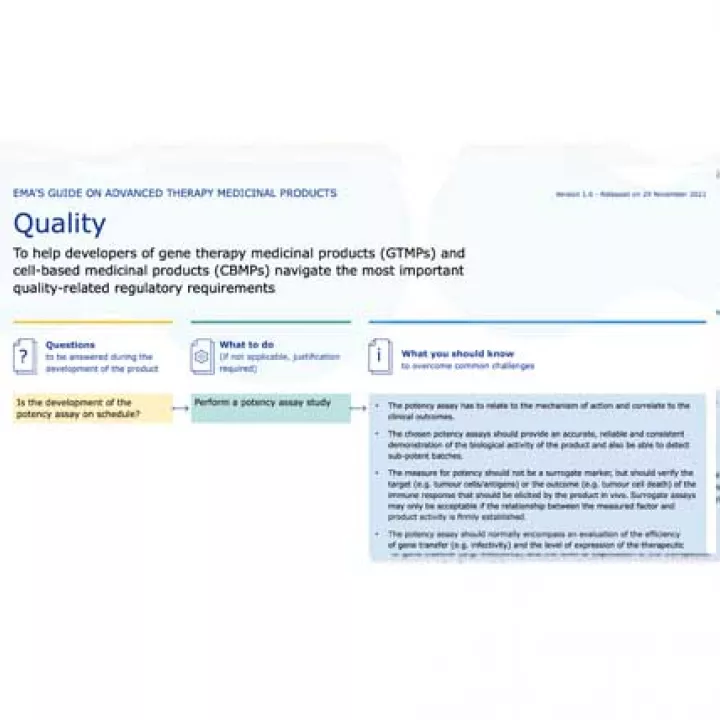La fabrication de médicaments de thérapie innovante (MTI) concerne la production à l’échelle industrielle de ces thérapies afin de soutenir le développement clinique et la commercialisation. Cette section présente un aperçu des processus de fabrication des MTI, des termes clés et des ressources associées.
La fabrication des médicaments de thérapie innovante (MTI) fait référence aux étapes de multiplication ou d’extension pour satisfaire à la demande croissante de doses destinées aux essais cliniques et à la commercialisation à l’échelle industrielle. La multiplication ou augmentation d’échelle (scale-up) consiste généralement à accroître la capacité de production par l’augmentation du nombre de cellules ou le volume de chaque lot, tandis que l’extension (scale-out) consiste à faire fonctionner en parallèle plusieurs unités opérationnelles de plus petite taille.
Les processus de fabrication des MTI varient considérablement en termes de complexité. À un niveau général, la thérapie génique repose sur un processus de fabrication similaire à celui des autres produits biologiques, tels que les médicaments à base de protéines ou les vaccins. Ce processus débute par une culture cellulaire de petite taille des cellules hôtes, qui est ensuite étendue et mise à l’échelle sur une série de lots plus grands jusqu’à atteindre le nombre souhaité de cellules hôtes. Les cellules hôtes sont ensuite transfectées avec de l’ADN plasmidique, codant les protéines nécessaires à la production virale, récoltées et lysées, pour libérer les vecteurs viraux. Ces vecteurs sont ensuite purifiés, testés pour leur fonctionnalité, puis formulés et conditionnés pour un usage clinique. Pour plus d’informations sur ces processus, consultez les ressources sur l’utilisation clinique des vecteurs lentiviraux et sur la gestion des obstacles dans la fabrication de vecteurs AAV pour la thérapie génique (en anglais).
La fabrication de la thérapie cellulaire débute par la collecte de cellules provenant d’un patient ou d’un donneur. Après isolation, manipulations in vitro et expansion sur le site de fabrication, les cellules sont réintroduites chez le même patient (autologues) ou chez plusieurs autres patients (allogéniques). En raison de leur nature, les thérapies cellulaires autologues sont généralement produites à petite échelle dans des installations de fabrication dédiées, situées à proximité du lieu de soins du patient. Les thérapies cellulaires allogéniques, quant à elles, peuvent être fabriquées par lots, et le développement du processus s’appuie sur les technologies de biotraitement déjà existantes pour la fabrication de médicaments biologiques. Les cellules thérapeutiques sont développées dans des bioréacteurs à grande échelle et conservées par cryoconservation, ce qui permet de produire de plus grands volumes à un coût thérapeutique réduit.
La qualité est un facteur déterminant dans le profil de sécurité et d’efficacité des MTI. Pour garantir la qualité des MTI, des essais de contrôle qualité en cours de fabrication sont intégrés au processus de production, et les critères de qualité des tests de libération doivent être respectés.

Le respect des Bonnes Pratiques de Fabrication (BPF) garantit que les médicaments sont systématiquement produits en conformité avec des normes de qualité. Toutefois, la fabrication des MTI présente des défis spécifiques en matière de qualité. Les MTI sont des produits d’une grande complexité et des risques peuvent survenir tout au long du processus de fabrication, en fonction du type de produit, de la nature des matières premières et des procédés de fabrication. Le produit final peut ainsi présenter des variations dues à l’utilisation de matériaux biologiques (par exemple, des matériaux vivants interagissant avec le corps humain) ou à des manipulations complexes (telles que des altérations des fonctions cellulaires). Il devient dès lors impératif d'introduire un certain degré de flexibilité dans la définition des exigences des BPF pour tenir compte de ces particularités inhérentes aux MTI.
La prise en compte de ces défis a conduit à l’élaboration de lignes directrices concernant des BPF spécifiques aux MTI. Ces lignes directrices peuvent être consultées sur le site de la Commission Européenne, accompagnées d’une Foire Aux Questions détaillée, créée par l’Agence Européenne des Médicaments. Les lignes directrices relatives aux BPF pour les MTI ont été adaptées à partir des exigences des BPF générales concernant tous les médicaments dans l’Union Européenne afin de tenir compte de la complexité particulière des MTI et de leurs modes de fabrication. Une approche fondée sur l’évaluation des risques (voir page 8) peut être utilisée par le fabricant pour concevoir les mesures organisationnelles, techniques et structurelles nécessaires à la mise en œuvre de cette flexibilité tout en garantissant un "système de qualité pharmaceutique" d’un niveau élevé, visant à préserver la qualité des MTI.
Les défis additionnels rencontrés dans la fabrication des MTI incluent : la nécessité de maintenir la stérilité tout au long du processus de fabrication, l'exigence de contrôle et de surveillance en continu, la complexité des procédés de fabrication, la courte durée de vie et des coûts de fabrication élevés. Des méthodologies de fabrication innovantes, telles que l’automatisation, l’utilisation de systèmes fermés, l’analyse de processus et la fabrication décentralisée, sont en cours de développement et d’application afin de répondre à ces défis.
Remerciements
Publication : 29/01/2022
Auteur :
Hsin-Yu Kuo, EuroGCT Project Manager - Research Information and Networks
Relecture :
Aurélie Mahalatchimy, EuroGCT WP4 Convenor, UMR 7318 DICE CERIC, Aix-Marseille University, CNRS, Aix-en-Provence- France
Traduction de l'anglais au français en mai 2025 :
Victoria Burakova-Lorgnier, Juriste, UMR 7318 DICE CERIC, Aix-Marseille Université, Aix-en-Provence, France
Luc-Sylvain Gilbert, Chargé d'information EuroGCT en matière éthique, juridique et sociétale
Aurélie Mahalatchimy


